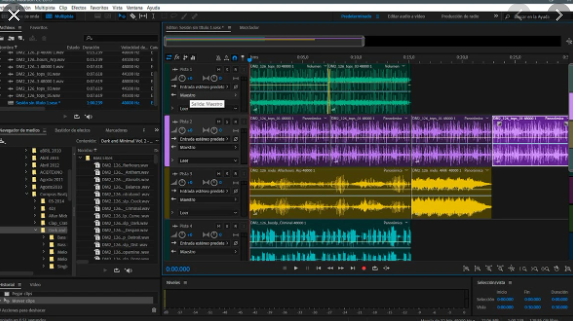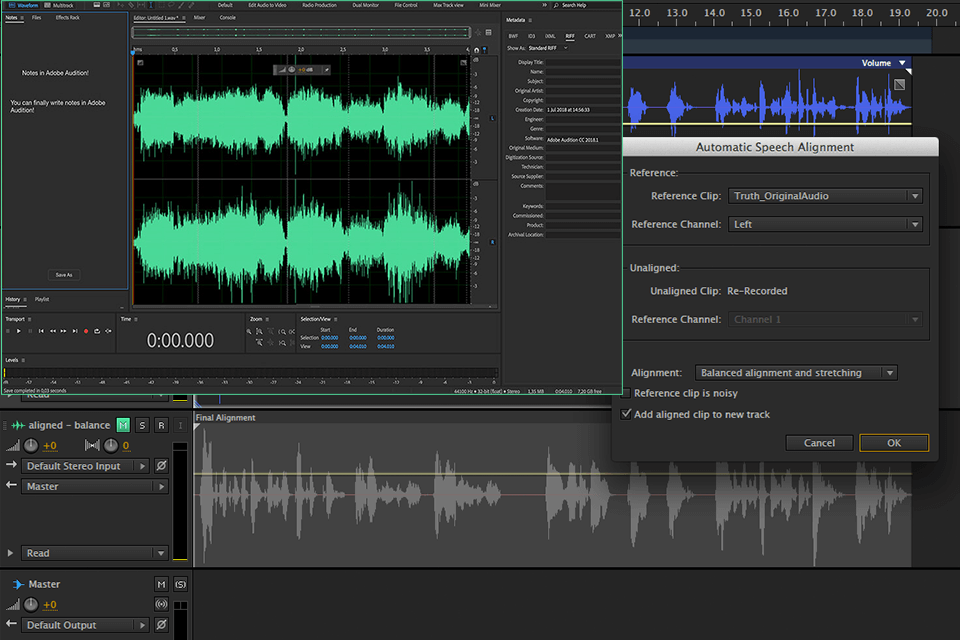Audio can be seen as a dark art to anyone new to video; what microphone should you use, what settings, and how do you clean up audio ready for use?
What few photographers realise is that audio is more important than the visuals in many cases. You can often get away with short stints of out of focus and unstabilised footage, but get the audio wrong, and it stands out a mile.
I am Ok with FCPX, but quite new to Adobe Audition. I spent a few hours today looking for explanations of how to work with really long audio fileslonger than one hour. In particular, I recorded an eventthe two event speakers were miked, and there was an in-room audience mic which picked up a few intermittent questions. Step 2: Recording. First things first, you need to open a new multitrack. Click FileNewMultitrack Session. A window will open asking you some basic options. You don't need to change anything other than the name so you can find it easier, and the Folder Location which is again your choice to change. Integrate Adobe Audition into your post production workflow! Utilize Audition’s powerful tools for fixing common audio problems like background noise, hum, clipping, clicks and pops. Adobe Audition can quickly clean up audio and fix problems that Premiere Pro cannot. In this post we cover common audio problems that you may encounter in your.
Not sure what type of microphone you need? Then check out our in-depth guide to what microphone you need and how to use them. If you’re vlogging then check out Jeff’s article on the best vlogging microphones
We’ve all heard audio that’s too quiet, effected by background noise or just a bit all over the place. Thankfully, more often than not, it’s not too tricky to fix without spending too much time on it.
The first thing to do is head to an application such as Adobe Audition; you can get a free trial at https://www.adobe.com/uk/
Once open drag and drop the audio you want to clean up directly into Audition and get started.
01 Opening the audio file
Drag and drop the audio file that you want to edit into the Audition files panel. If you have a movie file and haven’t separated the audio from the video, don’t worry. You can drag and drop this into Audition. The application will split the two automatically.
02 Normalise the audio
Use Ctrl-A or Cmd A to select the entire timeline and then Effects > Amplitude and Compression > Normalize (Process) and then Normalise to 98% and Normalize all Channels and click Apply. You should see the waveform increase.
03 Normalize tricky audio
Sometimes you’ll find there are spikes in the waveform that prevent you from Normalizing the Wave; this could be a clap, cough or anything that causes the audio to spike. You can tackle this in one of two ways depending on if you need that piece of audio or not.

04 Reduce tricky audio
If the audio that’s causing the spike is something that you need, say a laugh or clap then use the Cursor to select the audio spike and then use the Amplitude adjustment in the dialogue next to the waveform to reduce the level of the audio.

05 Delete tricky audio

A more drastic option is to delete the offending audio. Select the spike with the Cursor and hit delete. This will remove it completely from the timeline. I often like to get the audio normalized before starting the editing process to hear exactly what I have.
06 Remove background noise
One of the biggest audio issues is background noise; this can be air con, fans, traffic or all manner of things that you’ll only hear if you’re focusing on sound. While you can’t remove everything, you can easily remove drone or constant sounds. Start by locating an area of quiet in your soundtrack; you’ll need to zoom in. Then highlight a small section.
07 Capture the Noise print
Select Effects > Noise Reduction / Restoration > Capture Noise Print and agree. Now select the entire waveform and go back to Effect > Noise Reduction / Restoration > Noise Reduction Process, pick up the point at 0Hz and move it to meet the graph and then repeat for 24,000Hz. Now tap play to listen to the effect, adjust the effect with the two sliders, and click Apply.
08 Reduce echo
Echo is another factor that can be a real pain if you want professional quality audio. Thankfully Audition has a new feature to help called DeReverb. Again select the entire waveform and Effects > Noise Reduction / Restoration, use the Amount slider to adjust the effect and click apply.
09 Vocal Enhancer
That’s your audio hopefully cleaned and sounding far better than when it was downloaded from your audio recorder or camera. While it may already sound better, there are still plenty of effects that you can apply to enhance the sound of your audio. The fastest is found under Effects > Special > Vocal Enhancer. It’s a small boost but one that makes a real difference.
Integrate Adobe Audition into your post production workflow! Utilize Audition’s powerful tools for fixing common audio problems like background noise, hum, clipping, clicks and pops.
Adobe Audition can quickly clean up audio and fix problems that Premiere Pro cannot. In this post we cover common audio problems that you may encounter in your video editing and post production – and how to address these issues using the tools within Adobe Audition.
If you’re looking for tips on a Premiere Pro to Audition workflow, check out my previous posts on roundtripping your video editing clips and sequences into Audition and back to Premiere.
Noise Reduction in Audition
Adobe Audition has powerful noise reduction tools that be accessed in the Waveform Editor. If you are in a Multitrack Session, double click on a track to go into the Waveform Editor.
Click and drag to select several seconds of background/ambient only sound. The more time you have to sample the better your results will be. Make sure you do not select any audio with voices or other noises!
Go to Effects > Noise Reduction (process). Click “Capture Noise Print” and then “Select Entire File”.
Click “Noise Only” to hear what you are removing (deselect it before you click apply). Click the green button on & off to toggle the effect as you adjust the “Noise Reduction” & “Reduce by” sliders.
If you prefer shortcuts, use Shift +P to save a noise print and CMD/CNTRL/Shift + P to open the “Noise Reduction” Effect. I suggest making shortcuts for effects you commonly use (do this by accessing the shortcut editor in the menu bar, Edit >Keyboard Shortcuts).
Adaptive Noise Reduction
Adaptive Noise Reduction automatically learns what noise is, as long as you have background noise before people start speaking. To take advantage of this tool, it is a good habit to always record 4-5 seconds of audio before your talent starts speaking.

In Adobe Audition, you can also combine Adaptive Noise Redution with other effects in the Effects Rack (which you can’t do with standard Noise Reduction). It is part of several presets like “Clean up and Level Voice-Over” that can help you get started if you are new to audio effects.
Remove Hum in Audition
This Adobe Audition effect comes in handy if you are doing a lot of location filming where you can’t control the production environment.
Use this to remove AC hum (lights, power lines, electronics). In my example I was picking up hum from an Xbox 360 in the room.
Go to Effects > Noise Reduction/Restoration > Dehummer. Select your preset based on country. I’m in the states so I picked 60Hz.
Auto Heal & Spot Healing
You can use Auto Heal & the Spot Healing Brush to remove clicks, pops, and other short noises you want to remove from your audio.
Zoom in by pressing the plus key and select the pop. Right click and select “Auto Heal” (Comm/Control + U).
You can also paint a selection with the spot healing brush(B) by dragging over the area to fix in the “Spectral Frequency” display.
Using the Diagnostic Panel
Access the Diagnostics panel in Audition by choosing Window > Diagnostics from the menu bar. The powerful diagnostic panel provides tools to fix clipping, clicks and pops in your audio.
The Declipper is handy for repairing clipped audio. Select the DeClipper Effect in the Diagnostic panel. Click Scan and your clipping areas will be listed. Select a listed problem to move to it in the waveform.
You can fix each one at a time or click Repair All.
Note: Depending on your audio it may still appear clipped, as Audition works in 32 bit floating point. Decrease the amplitude or use Normalize to see that the audio isn’t actually clipped. I have had varied results with the DeClicker, so if it dozen’t fix your issues, you the manual method mentioned above using Auto Heal & Spot Healing Brush.
Before:
After:
Does Adobe Audition Come With Music Beds
Utilize a Premiere to Audition workflow to take advantage of these great audio tools in your video editing projects. For more details on working with audio in Adobe Audition see Adobe Help.